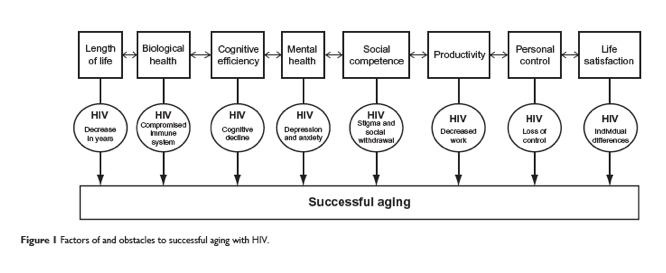| |
Mental Health in Aging with HIV - Suicide Ideation Will Increase in
Aging Older HIV+ - Successful aging and the epidemiology of HIV
|
| |
| |
Download the PDF here
David E Vance, Teena McGuinness, [...], and Pariya L Fazeli
https://www.ncbi.nlm.nih.gov/pmc/articles/PMC3147048/
HIV & Aging - Mental Needs: Policy, Mental Health Services Program, Comorbidities, Services for Aging/Older HIV+ - (09/29/14)
HIV & Aging: Failure to Normalize Immunity Despite Decade of Successful HAART - (06/16/14)
HIV & Aging: HIV and the aging kidney - (06/16/14)
HIV & Aging: Biologic aging, frailty, and age-related disease in chronic HIV infection - (06/16/14)
HIV & Aging: Immunosenescence and aging in HIV - (06/16/14)
HIV & Aging: Update on metabolic issues in HIV patients - (06/16/14)
HIV & Aging: Coping styles and illicit drug use in older adults with HIV/AIDS - (06/16/14)
HIV & Aging: Psychosocial, mental health, and behavioral issues of aging with HIV - (06/16/14)
HIV & Aging: Demographics of HIV and aging - (06/16/14)
HIV & Aging: African Americans, Hispanics, Caucasians (2 MACS Studies) - (06/09/14)
Eight factors of successful aging
with HIV

HIV has been associated with poor mental health in two ways: 1) poor mental health can predispose one to HIV infection and, 2) a diagnosis of HIV can result in poor mental health. First, poor mental health can lead to poor judgment and decision-making, which results in placing oneself in a situation where exposure to HIV infection is increased.
Regardless, numerous studies show that in general, older adults with HIV perform worse on cognitive measures (eg, attention, memory, speed of processing, reasoning) compared to same-aged peers without HIV and younger adults with HIV.20,27–30 Likewise, these same studies also show younger adults with HIV perform worse on cognitive measures compared to same-aged peers without HIV. This decline in cognitive efficiency is of concern since it can negatively affect emotional equilibrium (problem solving an emotional obstacle) and performance on Instrumental Activities of Daily Living (IADLs) such as medication adherence (remembering to take medications), managing finances (reasoning how much one owes), and driving (visual speed of processing needed to avoid automobile crashes).21
Based on this prevalence, it is important to identify potential areas that may lead to such anxiety, depression, and especially suicidal ideation in those aging with HIV. From the literature, a number of stressful factors that may play a role in suicidal ideation in this clinical population have been identified for intervention; these include changes in appearance (eg, lipoatrophy in the face), HIV-related stigma, ageism, declining health, fatigue, neurological changes related to poor cognitive functioning, declines in social support and loneliness, and financial distress.38 Thus, the following recommendations were posited to improve mood and reduce
negative affect and the prevalence of suicidal ideation; these include financial planning to reduce financial distress, learning to access spiritual supports, counseling, antidepressants, and addressing healthy lifestyle choices (eg, exercise, stress reduction).
HIV is a stigmatizing, life-threatening disease often associated with fear, guilt, and uncertainty; thus, a diagnosis of HIV can result in intense anxiety, depression, and even suicidal ideation. In fact, the prevalence of anxiety and depression remains remarkably high across the lifespan, even into later life. In the prior study on comorbidity prevalence across the life span of 1478 HIV outpatients, the prevalence of anxiety in those in their 50s or 60s and greater were 20.3% and 12.3%, respectively; likewise, the prevalence of
depression in the same two age groups were 45.8% and 36.4%, respectively.22 Although these rates are reduced in the much older group, this may also reflect survival bias in that those who are successfully aging may be hardier in general.
Clearly, screening and monitoring mood disturbances such as these are important mental health issues for patient care, but especially for those who may be experiencing extreme mood disturbance, specifically suicidal ideation.
Social competence consists of the ability to process social interactions constructively to secure physical, emotional, and intimate needs.7 From the perspective of social exchange theory, being socially competent entails possessing a sense of worth in which one can socially exchange with another's worth.50 With a diagnosis of HIV, there often comes a sense of being "damaged goods" or "possessing a questionable character" that compromises this sense of worth. This diminished sense of worth can be internalized by the person with HIV or externalized by the person with whom he or she is socially interacting and exchanging. This diminished worth can be further threatened by ageism, homophobia, and/or lack of education or financial means.51 Attractiveness can even play a part; those who experience disfiguring of the face due to lipoatrophy caused by HAART may experience a further loss of social worth.
As social worth decreases, social competence may be compromised, and this may result in social withdrawal which is often observed with HIV, especially older adults with HIV.48 For example, in a sample of 160 older adults with HIV, 71% reported living alone, only 47% reported having a committed intimate relationship, and 57% reported that their emotional needs were unmet. Furthermore, this sample reported that their primary social supports were others with HIV.52 This becomes particularly germane given that with
age in general, social networks become smaller due to attrition from poor health, lack of financial resources required to engage in social activities (eg, traveling, dining out), and death of others in their social network.53
many are facing an uncertain retirement, well aware that they do not have the means to live at a decent standard of living. This
is further complicated by the fears of uncertain economic conditions that foster severe cutbacks in social programs for the indigent, infirm, and elderly
|
|
| |
| |
|
|
|